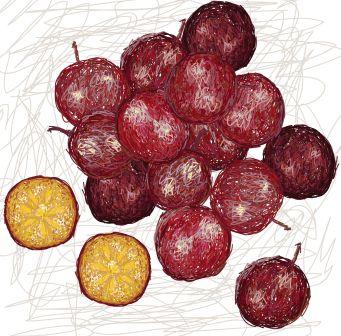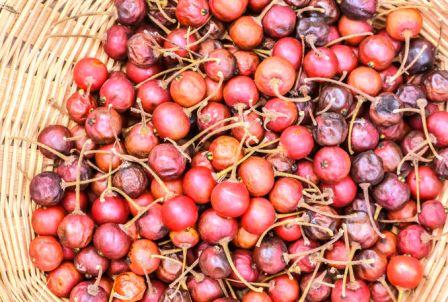Flacourtia indica – Governor’s plum Uses, Dose, Research
Vikankata – Flacourtia indica is a recent inclusion to Ayurvedic pharmacopoeia. It is widely used in treating liver disorders, has anti malarial, anti bacterial and anti cancer potential.

Botanical name- Flacourtia indica, Syn. Flacourtia ramontchi L. Herit.
Family- Flacourtiaceae (Vikamkata kula)
Table of Contents
Taxonomy
Domain : Eukaryota
Kingdom : Plantae
Sub kingdom : Viridaeplantae
Phylum : Tracheophyta Subphylum : Euphyllophytina Infraphylum : Radiatopses
Class : Magnoliopsida
Sub class : Rosidae
Super order : Violanae
Order : Malpighiales
Family : Salicaceae
Tribe : Flacourtieae
Genus : Flacourtia
Specific epithet : sepiaria – Roxb.
Botanical name : Flacourtia sepiaria Roxb.
Vernacular names
Names in different languages:
Hindi name- Kantayi, Baichi, Katai, Kondai,
English name- Madagascar plum, ramontchi, governor’s plum, batoko plum, and Indian plum,Madagascar plum
Kannada name – Dodda Gejjalakai, Llumanika,
Telugu name- Kanavegu chettu
Thai name – Takhop pak, Ta-khop-pa
Malay name – Kerkup kechil
Malayalam name – Conoron
Marathi name – Kaker, Bhekal
Punjabi name – kingaro, sherwam
Tamil name – Sottaikala, Kanru, Kattukala.
Telugu name – Conrew, Mulu Tiruman.

Oria name – Tuturi
Lao name – Gen
Vietnamese name – b? quân ?n or mùng quân
Bengali name – Boichi in Bengali
Tagalog name – bitongol, bolong, and palutan. In
African name – Kokowi and
Simhalese name – Uguressa
French name – prunier de Madagascar, grosse prune de café.
German name – echte Flacourtie
Spanish name – Ciruela governadora
Burmese name – na-yu-wai
Shona name – munhunguru
Sanskrit Synonyms
Vyaghrapada, Granthila, Swadu Kantaka, Kanta Pada, Gopaghonta, Sruvadruma, Sruva Vruksha, Dantakashta, Yajneeya, Brahmapadapa, Pinda Rohinaka, Kinkini,
Bahuphala – having many fruits
Mruduphala – having soft fruit
Classical categorization
Raja Nighantu – Prabhadradi Varga
Bhava Prakasha – Amradi Phalavarga (group of fruits like mango)
Major chemical constituents
Fruits contain protein and sucrose;
Bark yields tannin and Flacoutin, a phenolic glucoside ester
?-sitosterol, ?-sitosterol-?-D-glucopyranoside, Ramontoside, Butyrolactone lignan disaccharide and flacourtin.
coumarins (Nazneen et al., 2002) and phenolic glycosides (Kaou et al., 2010).
Distribution
Widely distributed in India, Bangladesh, Thailand, Malaysia
Medicinal properties
Flacourtia ramontchi Medicinal Properties
Rasa (taste) -Amla (sour), Madhura (fruit)
Guna (qualities) – Laghu (lightness)
Vipaka – Madhura – Undergoes sweet taste conversion after digestion
Veerya – Sheeta – It is a coolant.
Effect on Tridosha – Balances all the three Doshas.
Part used, dosage
Part used- Bark, fruit, leaf
Dosage-
Decoction 50-100 ml; fresh juice 10-20 ml
Sanskrit verse

Medicinal uses, indications
Flacourtia indica medicinal uses:
Deepana – improves digestion strength
Pachana – Digestive, relieves Ama Dosha
Indicated in-
Kamala – Jaundice, Liver disorders
Asra – blood disorders such as abscess, skin disorders, bleeding disorders such as menorrhagia, nasal bleeding etc.
Pittaroga – Pitta imbalance disorders
The Governor’s plum fruit is eaten raw or made into jelly or jam. It is fermented to prepare wine.
Fruits are used as appetizing and digestive, diuretic, in jaundice and enlarged spleen.
The leaves and roots are used for treatment of snakebite.
The bark is used in treating arthritis, intermittent fever.
Roots are used in nephritic colic and gum is used in cholera
Most parts of the plant are used for cough, pneumonia, and bacterial throat infection, diarrhea .
As per Rasa Chandamshu, this herb is used in preparing Swarna Bhasma – Calx of Gold
Research
Anti anxiety activity
antibacterial (Eramma and Devaraja, 2013)
Antimalarial (Kaou et al., 2010),
Diuretic activity of roots
Hepatoprotective (Nazneen et al., 2009) and
Anti-inflammatory (Kundu et al., 2013) activities of methanol extract of F. indica (FIM).
Protective effects against paracetamol-induced hepatotoxiciy in rats
Evaluation of anti cancer activity
Side effects
Seek medical advice for its use during pregnancy and lactation.
It can be used in children in small doses.
Interaction with medicines, supplements
Can this be used while taking Homeopathic medicine?
Yes. This product does not react with homeopathic medicine.
Can this medicine be continued while taking supplements like multivitamin tablets, Omega 3 fatty acids etc?
Yes. Generally, this product goes well with most dietary supplements. However, if you are taking more than one product per day, please consult your doctor for an opinion.
With western
medicines
Seek your
doctor’s advice if you are taking this product along with other western
(allopathic / modern) medicines. Some Ayurvedic herbs can interact with modern
medicine.
If both Ayurvedic and allopathic medicines are advised together, then it is
best to take Allopathic medicine first, wait for 30 minutes and then take the
Ayurvedic medicine.
Sthanika Karma (Systemic Action)
Externally
Anti-inflammatory in action. External application is indicated in Inflammatory swellings. Lymph Node enlargement, Abscess etc.
Internal administration-
Digestive system – Carminative and Hepatoprotective. Indicated in low digestive power and in jaundice.
Circulatory system – Acts as a blood purifier
Excretory system – reduces urine output. It is indicated in diabetes.
Tvak – Indicated in skin disorders










